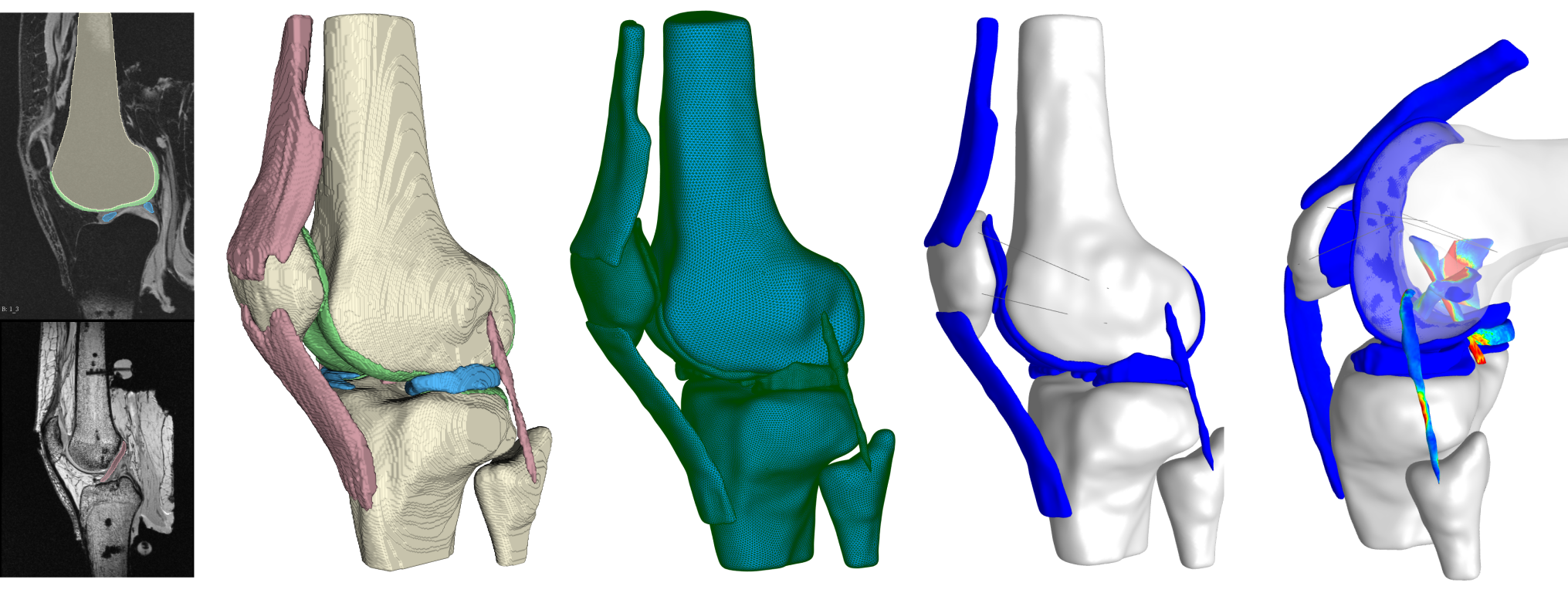Our research program treats computational models as end-point technologies to realize routine use of simulation for biomechanics research, medical training, and patient care. As potentially enabling technologies for modeling and simulation, virtual knees have been developed and disseminated through our Open Knee(s) initiative. The activity started with an early model of the tibiofemoral joint, which is now referred as Open Knee(s) – Generation 1. The model included bones as rigid bodies; cartilage as nearly incompressible Neo-Hookean, menisci as orthotropic hyperelastic, and ligaments as transversely isotropic hyperelastic materials. Contact between articulating surfaces were modeled as frictionless. This virtual knee has the capacity to predict joint movements under given external loads and provides a full field estimation of tissue stresses and strains using FEBio for finite element analysis. The model was publicly disseminated as is, supported by a user’s guide. In following years, the development team published scholarly work related to the development of the model, its evaluation against joint mechanics data from literature, and promotion of its reuse. This model was the first and for a long time, the only, finite element representation of the natural knee that was publicly available for download. This early model has been downloaded more than 900 times. Users indicated their intentions for downloading this model as for research, for training, to use as reference to other models, to evaluate, to examine ligament function, to explore cartilage mechanics, for analysis of meniscal injury, for instrumentation design, for impact biomechanics, to use tissue geometries, among many others. Scholarly work by us and by others depended on this virtual knee; more than 35 publications used the whole model or parts of it. Topics of these studies, and therefore model use cases, were numerous: cruciate ligament deficiency, performance of anterior cruciate ligament grafts, evaluation of novel contact algorithms, tissue stress-strain during exercise, meniscus mechanics, meniscal implants, unicompartmental knee arthroplasty, geometric uncertainty, to name a few. Some of these studies utilized FEBio as the simulation software, which this virtual knee was generated for and tested in. Surprisingly, many more decided to use Abaqus and a relatively small group utilized other finite element analysis packages. Most recently, a few end-users incorporated components of the model into musculoskeletal movement simulation platforms. While a handful of users conducted simulations with the full model, many used the geometries or extracted meshes of some or all of the tissues, and rebuild the virtual knee their own way. This early experience demonstrated the variety of user behavior and motivates diversification in the dissemination of virtual knees. It is also a testament to the success of free and open source model sharing and its place in the ecosystem of computational biomechanics.
Our efforts to build and disseminate virtual knees expanded with Open Knee(s) – Generation 2, where the overall goal has been to provide computational knee models for a small but diverse sample population of knee specimens. Comprehensive imaging and joint testing were performed primarily driven by development, calibration, and benchmarking of models in a specimen-specific manner. Open Knee(s) project continues to expand the dissemination of virtual knees to empower a broader biomechanics community and support their diverse use cases. A growing number of knee joint models, supported by comprehensive specimen-specific data can be found at the project site (https://simtk.org/projects/openknee).
Erdemir, A. (2016) Open Knee: open source modeling and simulation in knee biomechanics, Journal of Knee Surgery, 29, 107-116. DOI: https://dx.doi.org/10.1055%2Fs-0035-1564600. PubMed Central: https://www.ncbi.nlm.nih.gov/pmc/articles/PMC4876308/.


